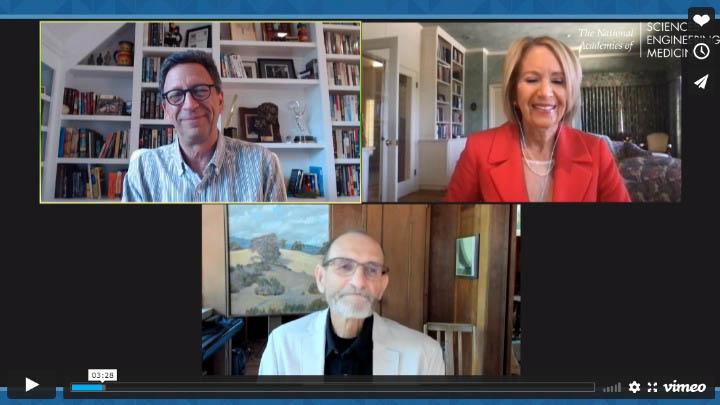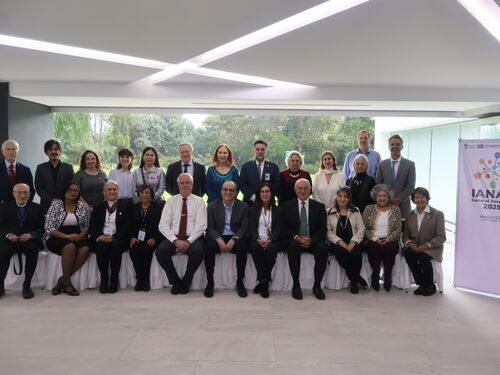Should Solar Geoengineering Be Considered in the Fight Against Climate Change?
Feature Story
By Cady Stanton
Last update June, 11 2021
A recent discussion explored the possible risks and benefits and the need for more research
Climate change is creating impacts that are widespread and severe — and in many cases irreversible — for individuals, communities, economies, and ecosystems around the world. 2020 was one of the three warmest years on record, bringing with it a number of costly climate disasters, including the worst wildfire season ever recorded in the Western U.S., historic flooding in China and other parts of Asia, and severe droughts in South America. With every year of inaction on global efforts to address climate change and drastically reduce greenhouse gas emissions, more frequent and more extreme events of this kind could become more likely, potentially increasing the need to consider some high-risk approaches to avoid the most serious, possibly catastrophic impacts.
One such approach, solar geoengineering, was the subject of the fourth event in a series of “Climate Conversations” hosted by the National Academies of Sciences, Engineering, and Medicine and the topic of the National Academies’ recent report Reflecting Sunlight: Recommendations for Solar Geoengineering Research and Research Governance. Solar geoengineering refers to strategies designed to cool Earth either by adding small reflective particles to the upper atmosphere, by increasing reflective cloud cover in the lower atmosphere, or by thinning high-altitude clouds that can absorb heat.

Participating in the discussion were Chris Field, director of the Stanford Woods Institute for the Environment, who chaired the committee that authored the National Academies’ report, and National Academy of Sciences President Marcia McNutt, a geophysicist who chaired a 2015 study on climate interventions. Award-winning journalist Frank Sesno, director of strategic initiatives at George Washington University’s School of Media and Public Affairs, moderated the conversation.
Reducing greenhouse gas emissions should be the centerpiece of efforts to combat climate change, said Field, but given the current climate trajectory, there is good reason to explore the viability of solar geoengineering and how it might fit into a broader set of climate change strategies.
“The fundamental question that [the National Academies] were asked to address is: Does it make sense to have a research program to further explore the question of whether or not solar geoengineering ought to be further considered for a place in the portfolio of climate change solutions?” said Field. “Because the impacts of climate change are advancing so rapidly, we really need to have a clear understanding of what the whole portfolio of possible solutions might look like and whether there’s a spot for geoengineering.”
Sesno kicked off the conversation by asking Field and McNutt to share their own definitions of solar geoengineering.
“Solar geoengineering is a grab bag term for any of a number of techniques to moderate how much sunlight reaches Earth’s surface to warm the planet,” said McNutt. But currently, our scientific understanding of solar geoengineering is limited. “We don’t even know if solar geoengineering is better than other options, and better for whom [and] in what way.”
‘Not a comprehensive solution’
There are many unknowns about the consequences of solar geoengineering and its effectiveness, and both panelists emphasized that the strategy is an unexplored option, and one that could only be considered after far more robust, extensive research.
Field and McNutt cited concerns about the possibility of detrimental physical and social consequences from solar geoengineering, including intensification of drought, threats to national security, and challenges related to issues of environmental justice and equity.
“Solar geoengineering is not a comprehensive solution,” said Field. He stressed that there are many aspects of climate change that the approach does not address, including ocean acidification. The effects of solar geoengineering on weather patterns and stratospheric ozone have not been adequately explored, he said. “Those are important enough that we wouldn’t even be close to arguing for deployment until we learn a lot more.”
“Once you already get to the point where it’s too difficult to adapt, and you haven’t mitigated, and the situation is so bad, what can you do to try to lessen how bad it is, by some sort of band aid?” One possible band aid is solar geoengineering, McNutt said.
Because the impacts of climate change are advancing so rapidly, we really need to have a clear understanding of what the whole portfolio of possible solutions might look like and whether there’s a spot for geoengineering.
The need for more research
McNutt and Field underscored the importance of doing much more research before any decisions are made.
“There’s been some modeling done, but models are only as good as the data that are [entered] into them,” McNutt said. “This is another reason why we need to do research to understand those impacts.”
Exploring the technical feasibility of solar geoengineering is a complicated process, made more challenging by public concerns about the approach, as the 2021 report notes.
“The social feasibility is, if anything, even more complicated than the technical feasibility, and it needs to be researched,” Field said. Early experiments proposed in recent years have been met with public resistance, which must be addressed for research in solar geoengineering to move forward. “Otherwise, it’s very likely that the agenda wouldn’t be able to move forward, even if it was technically a good idea,” Field said.
“I think when it comes to going beyond research, as Chris has said, this has to involve civil society; it cannot be a discussion [only] among scientists,” McNutt added.
Exploring a last-ditch option
The 2021 report recommends a national solar geoengineering research program, strong cooperation with other nations, robust research governance, and meaningful public engagement.
“There really are profound questions that have not yet been answered about what kind of governance structures could be effective,” Field said. “That’s part of the research agenda — to test-drive concepts about what might work and what might not.”
The next event in the Climate Conversations series is a June 17 conversation on the role of infrastructure and engineering in building a climate resilient future, featuring John L. Anderson, president of the National Academy of Engineering, and Thomas P. Bostick, former commanding general of the U.S. Army Corps of Engineers). Register here
Related Resources
Watch the recorded session
Register for our June 17 Climate Conversation on Infrastructure
Featured Publication
Consensus
·2021
Climate change is creating impacts that are widespread and severe for individuals, communities, economies, and ecosystems around the world. While efforts to reduce emissions and adapt to climate impacts are the first line of defense, researchers are exploring other options to reduce warming. Solar...
View details



